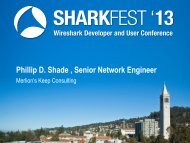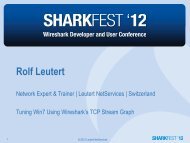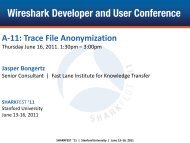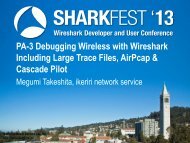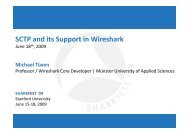Wireshark in a Multi-Core Environment Using Hardware Acceleration
Wireshark in a Multi-Core Environment Using Hardware Acceleration
Wireshark in a Multi-Core Environment Using Hardware Acceleration
You also want an ePaper? Increase the reach of your titles
YUMPU automatically turns print PDFs into web optimized ePapers that Google loves.
What problem does hardware acceleration solve? Network traffic is grow<strong>in</strong>g much faster than the comput<strong>in</strong>g power ofstandard servers Standard NICs are built for efficient data communications, notdata capture and analysis In order for capture and analysis applications to handle the<strong>in</strong>creased network utilization hardware acceleration is required.Napatech - Sharkfest 20095
Network process<strong>in</strong>g example10Gbps data per PortTotal 30 Mpps1Example of: Channel merge Filter<strong>in</strong>g Data type separation <strong>in</strong>multiple host buffers0Application MemoryVoIP process<strong>in</strong>g applicationEmail process<strong>in</strong>g applicationTotal CPU load on the server host for all features: < 1%!Napatech - Sharkfest20096
Adapter ArchitectureTime Stamp &GPS SyncDDR2 MemoryUp to 4GbEthernet XAUI InterfaceMacMacChannelMergePacketDecodeHashKeyGenStatisticsFilter, slice,compare& buffersplitBufferSystem&HandlerPCI-X / PCIeNapatech - Sharkfest20097
Merg<strong>in</strong>g of StreamsAll Napatech adapters support merg<strong>in</strong>g of streams.• When customer applications need to process both RXand TX data from a l<strong>in</strong>k, it is often important toprocess the request-response traffic <strong>in</strong> the correctorder.• The Napatech adapters support merg<strong>in</strong>g of data from2 or more ports <strong>in</strong>to a stream.• Merg<strong>in</strong>g of data is done based on the frame receptiontime. This means that request-response traffic willalways be delivered to the host <strong>in</strong> the correct order.• Process<strong>in</strong>g of packets <strong>in</strong> time order can be important:• When data is to be analyzed on the fly.• When data is to be stored for later analysis.• This functionality enables higher host process<strong>in</strong>gperformance.User applicationApplication framebuffer, mergedFrameFrameAdapter DMAOSStandard NICs do not have this functionality, whichmeans that received data must be sorted by thehost CPU.• Sort<strong>in</strong>g frames <strong>in</strong> time order by the host CPU reducesthe host process<strong>in</strong>g performance.• If data is to be stored on disk <strong>in</strong> time order, an extraCPU memory copy is needed.User applicationApplication framebufferFrameOSOS frame bufferFrameApplication framebufferFrameOS frame bufferFrameApplication framebuffer, mergedFrameFrameNapatech - Sharkfest 20098
Merg<strong>in</strong>g of Streams, Cont<strong>in</strong>uedThe Napatech adapters support tapp<strong>in</strong>g of network data.• Only the RX fiber needs to be connected.• L<strong>in</strong>e speed tapp<strong>in</strong>g us<strong>in</strong>g standard network taps is supported.• Data from related ports can be merged <strong>in</strong> time order.Napatech recommends the use of network taps <strong>in</strong>stead of switch SPAN ports fortapp<strong>in</strong>g of network data (see the table below).Feature Tap SPAN PortNapatech Adapter Standard Adapter Napatech Adapter Standard AdapterPackets are merged. Yes No Yes YesThe time order of packets is correct. Yes No No NoData can be captured at all traffic conditions. Yes No No 1 No 1All packets with errors can be captured. Yes No No NoThere are no requirements to the network setup. Yes Yes No 2 No 2No switch configuration is needed. Yes Yes No NoNotes:1. Often the switch SPAN has the same speed (e.g. 1 Gbps) as the ports it is monitor<strong>in</strong>g, so if two 1 Gbps switchports are mirrored to a 1 Gbps switch SPAN port, data gets lost if the network load on the two mirrored ports ishigher then 50%.2. The used switch must have a free SPAN port.Napatech - Sharkfest20099
Frame Burst Buffer<strong>in</strong>g on AdapterAll the Napatech adapters have on-board memory that can buffer networktraffic:• The NT20E adaptercan buffer up to 1200 ms of traffic <strong>in</strong> the on-board memory ifthe PCI bus is busy.• This feature is important when the PCI <strong>in</strong>terface or the host application does nothave the needed performance to capture bursts at l<strong>in</strong>e speed.Napatech AdapterStandard NICSmooth traffic.No packet loss.Bursty traffic.Risk of packet loss.HostbufferHostbufferNapatech - Sharkfest200910
OS Bypass, Zero CopyAll Napatech adapters support zero copy ofcaptured frames directly from the adaptermemory to the user application memory(bypass<strong>in</strong>g the operat<strong>in</strong>g system).Napatech AdapterFrameStandard NICFrameThe sav<strong>in</strong>g of avoid<strong>in</strong>g hav<strong>in</strong>g the OS tocopy all frames is considerable.• An NT20E Napatech adapter, us<strong>in</strong>g the zero copy<strong>in</strong>terface, will use less than 1% of one CPU core todeliver 12 Gbps data to the user applicationmemory.Adap pter DMAOSUser applicationApplication framebufferAdapter DMAOS CPU copyOSOS frame bufferFrameUser applicationApplication framebufferFrameFrameNapatech - Sharkfest 200911
Large Host BuffersAll Napatech adapters support large host buffers(limited by hardware address space).There are two benefits of us<strong>in</strong>g large host buffers:• The overhead <strong>in</strong>troduced by the driver and the operat<strong>in</strong>gsystem (OS) is kept to a m<strong>in</strong>imum, as many packets canbe passed to the application at a time.• The application can improve host CPU cach<strong>in</strong>g andthereby the host performance. This is done by prefetch<strong>in</strong>gthe frames to be processed, so that frames areavailable <strong>in</strong> the CPU cache when they are needed bythe CPU.• Napatech has measured that pre-fetch<strong>in</strong>g framesbefore they are needed by the CPU can give more thana 100% <strong>in</strong>crease <strong>in</strong> process<strong>in</strong>g speed.Standard NICs deliver frames to the host one at atime <strong>in</strong> separate host buffers:• The driver and the OS must process frames one at atime result<strong>in</strong>g <strong>in</strong> a large process<strong>in</strong>g overhead. At thesame time pre-fetch of frames is not possible.This results <strong>in</strong> a lower host process<strong>in</strong>g speed by a factorof 2 or more.TimeNapatech - Sharkfest 200912
Large Host Buffers, Cont<strong>in</strong>uedNapatech Host Buffers• 1, 2, 4, 8, 16 or 32 host buffers can be created.• Each host buffer split <strong>in</strong>to segments.• Number of segments and the segment size are user configurable.• Buffers can be assigned to physical ports or can be port-<strong>in</strong>dependent.• Adapter can direct traffic to <strong>in</strong>dividual buffers based to IP flow and or protocol filterNapatech - Sharkfest 200913
Packet DescriptorsHeaders vs. Descriptors• PCAP, “Standard” and “Extended” headers are referred to as PCAP, “Standard” and “Extended”descriptors.• To dist<strong>in</strong>guish them from network headers (e.g. MAC, IP, UDP or TCP).Descriptors are delivered to the application along with the entire Ethernet frame• Descriptors are created by the hardware and <strong>in</strong>serted <strong>in</strong>to the packet buffer along with thecaptured frame.Napatech - Sharkfest200914
Feature Details – DescriptorsPCAP descriptor:• Complient to standard PCAP format• Fixed 16 bytes size• 6 different time stamp formats supportedPCAP Descriptor31 24 23 16 158 700:Timestamp (31:0)4:8:12:00Timestamp (63:32)Capture Length (16-bit)Wire Length (16-bit)16:FrameNapatech native Standard Descriptors provide additional <strong>in</strong>formation about frame:• Timestamp, Wire Length and Capture Length fields located at same locations as for PCAPdescriptor• Other <strong>in</strong>formation like: Ethernet CRC and CV errors, IP, TCP, UDP check sums, etc.Napatech native Extended Descriptors provide additional packet classification data:• TCP/UDP source and dest<strong>in</strong>ation ports• Additional layer 2-3 decodes (VLAN, MPLS, ISL, ARP, IPv4, IPv6, etc.)• 2 and 5 tuple hash value• Offsets to IP, TCP and UDP portion of frame.Napatech - Sharkfest200915
L<strong>in</strong>e Speed Captur<strong>in</strong>g ReviewNapatech Adapter Feature Benefit Standard Network AdaptersFrame burst buffer<strong>in</strong>g onadapterLong PCI burstsLarge host buffersOS bypass, zero copy ofcaptured packets directly touser application memoryNo data is lost, even when captured databursts exceed the PCI <strong>in</strong>terface speed, orthe PCI <strong>in</strong>terface is temporarily blocked.For NT20X 2 x 10 Gbps can be handleddown to 150 bytes frames.For NT20X 1 x 10 Gbps can be handled atany frame size.Data is lost, when captured burstsexceed the PCI <strong>in</strong>terface speed, or thePCI <strong>in</strong>terface is temporarily blocked.Very high PCI performance can be achieved The PCI performance will depend on thefor all frame sizes. frame size. E.g. the overhead for a 64-byte frame can be as much as 45%,while for a 1-KB frame it will be only 5%.Data can be processed at much higherspeed, and the frame process<strong>in</strong>g overheadis much lower (releas<strong>in</strong>g process<strong>in</strong>g powerto the user application).There is no packet copy<strong>in</strong>g or OS handl<strong>in</strong>goverhead.Merg<strong>in</strong>g of streams Adapters can merge packets received on 2or more ports <strong>in</strong> reception time order,whereby the host CPU is off-loaded.Frames are handled one at a time giv<strong>in</strong>ga large process<strong>in</strong>g overhead result<strong>in</strong>g <strong>in</strong>lower user application speed.A standard OS packet handl<strong>in</strong>g <strong>in</strong>terfaceperforms one or more copy of all framesresult<strong>in</strong>g <strong>in</strong> lower application speed.The sort<strong>in</strong>g of frames <strong>in</strong> time order mustby done by the host CPU, reduc<strong>in</strong>g thepossible host process<strong>in</strong>g performance.16
Programmable Adapter FiltersFilter functionality:• 64 fully programmable filters.• Received frames can be filtered at full l<strong>in</strong>e speed for all frame sizes andall comb<strong>in</strong>ations of filter sett<strong>in</strong>gs.• Dynamic offset of filters, based on automatic detection of packet type:• 26 predef<strong>in</strong>ed fields (Ethernet, IPv4, IPv6, UDP, TCP, ICMP, …)(see next slide for example)• Fixed offset relative to dynamic offset position.• Predef<strong>in</strong>ed filters: IPv6, IPv4, VLAN, IP, MPLS, IPX.• 64-byte patterns can be matched.• The length of the received frame can be used for filter<strong>in</strong>g frames.• The port on which the frame was received can be used for filter<strong>in</strong>g.Benefits:• Enables filter<strong>in</strong>g of network frames so that the user application onlyneeds to handle relevant frames, off-load<strong>in</strong>g the user application.• Filter<strong>in</strong>g can be done at network l<strong>in</strong>e speed.Napatech - Sharkfest 200917
Programmable Adapter Filters, Cont<strong>in</strong>uedFilter Example• The figure below illustrates how filters can be used to capture IP/UDP and IP/TCP frames• NTPL syntax:Capture[Priority=0; Feed=0] = ((Layer3Protocol == IP) AND((Layer4Protocol == UDP) OR (Layer4Protocol == TCP)))Napatech - Sharkfest200918
Fixed Slic<strong>in</strong>gAll Napatech adapters support fixed slic<strong>in</strong>g.Us<strong>in</strong>g fixed slic<strong>in</strong>g it is possible to slice captured frames to a fixed maximum length before they aretransferred to the user application memory.The fixed slic<strong>in</strong>g is configured us<strong>in</strong>g the NTPL:• Example: Slice captured frames to a maximum length of 128 bytes:Slice[Priority=0; Offset=128] = all• Note: snaplen <strong>in</strong> libpcap translated automatically to slic<strong>in</strong>g <strong>in</strong> hardwareFor many use cases it will be much more useful to use the dynamic slic<strong>in</strong>g functionality of theNapatech adapters(see next slide).Napatech - Sharkfest 200919
Dynamic Slic<strong>in</strong>gAll Napatech adapters support dynamic slic<strong>in</strong>g :• Dynamic slic<strong>in</strong>g functionality is supported:• Slic<strong>in</strong>g relative to a recognized protocol header (e.g. 32 bytes after the UDP header)• Slic<strong>in</strong>g based on filter<strong>in</strong>g results (e.g. different slic<strong>in</strong>g for UDP and TCP frames)• Slic<strong>in</strong>g priorities are supported:• Enabl<strong>in</strong>g different slic<strong>in</strong>g of different frame types (see example below)The dynamic slic<strong>in</strong>g functionality is based on the packet classification of dynamic offset <strong>in</strong>formation.The dynamic slic<strong>in</strong>g is configured us<strong>in</strong>g the NTPL:• Example: Dynamic slic<strong>in</strong>g us<strong>in</strong>g priorities and filter<strong>in</strong>g: Slice TCP frames to a length of the TCP header + 32bytes, other IP frames to a length of the IP header + 32 bytes and all other frames to a length of 128 bytes:Slice[Priority=2; Offset=128] = allSlice[Priority=1; Offset=32; Addheader=Layer2And3HeaderSize] = (Layer3Protocol == IP)Slice[Priority=0; Offset=32; Addheader=Layer2And3And4HeaderSize] = (Layer4Protocol == TCP)The dynamic slic<strong>in</strong>g enables reduction of the amount of data that must be transferred to the hostmemory and that the user application needs to handle.Napatech - Sharkfest 200920
<strong>Multi</strong> CPU Buffer Splitt<strong>in</strong>g, Cont<strong>in</strong>uedNTPL is used to def<strong>in</strong>e multi CPU host buffer splitt<strong>in</strong>g.• Example 1 (us<strong>in</strong>g the filter logic, see also the figure at previous slide):HashMode = NoneCapture[Priority=0; Feed=0] = (Layer4Protocol == UDP)Capture[Priority=0; Feed=1] = (Layer4Protocol == TCP)Capture[Priority=0; Feed=2] = (Layer3Protocol == ARP)Capture[Priority=0; Feed=3] = (((Layer4Protocol !== UDP) AND (Layer4Protocol != TCP)) AND(Layer3Protocol != ARP))• Example 2 (us<strong>in</strong>g 5-tuple hash, data distributed to 16 host queues):HashMode = Hash5TupleCapture[Priority=0; Feed=(0..15)] = All• Example 3 (us<strong>in</strong>g a comb<strong>in</strong>ation of filter logic and hash key to def<strong>in</strong>e flows):HashMode = Hash5TupleSortedCapture[Priority=0; Feed=(0..3)] = (mUdpSrcPort == (16000..16500))Capture[Priority=0; Feed=4,5] = (mTcpSrcPort == mTcpPort_HTTP)Capture[Priority=0; Feed=6] = (((Layer3Protocol == IP) AND(mUdpSrcPort != (16000..16500))) AND(mTcpSrcPort != mTcpPort_HTTP))Capture[Priority=0; Feed=7] = (mMacTypeLength == mMacTypeLength_ARP)Napatech - Sharkfest 200922
<strong>Multi</strong> CPU Buffer Splitt<strong>in</strong>g, Cont<strong>in</strong>uedWhat is the advantage of multi CPU buffer splitt<strong>in</strong>g?• It enables/simplifies distribution of the process<strong>in</strong>g of the captured data on multipleCPU cores. Provid<strong>in</strong>g a higher user application performance.• The <strong>in</strong>telligent distribution of captured frames (e.g. us<strong>in</strong>g a sorted 5-tuple hash key)on multiple buffers will <strong>in</strong>crease the cache hit rate of the host CPU cores. Improved cache hit rate can significantly <strong>in</strong>crease the user application performance.• The Napatech multi CPU buffer splitt<strong>in</strong>g implementation supports the L<strong>in</strong>ux Numamemory localization functionality. In AMD multi CPU configurations it means thatmemory accesses can be distributed on multiple memory controllers. The <strong>in</strong>creased memory bandwidth can <strong>in</strong>crease the user application performance.`Napatech - Sharkfest 200923
DeduplicationDeduplication is a functionality that discards duplicate frames.Duplicate frames are typically received:• When the network is monitored at a router span port, or• When monitor<strong>in</strong>g two MPLS l<strong>in</strong>ks used to implement a replicated MPLS l<strong>in</strong>k.The NT adapter recognizes a frame as a duplicate frame when:• The two frames are received on the same physical port or on the same port set.• There is a time and frame limit for discard<strong>in</strong>g duplicate frames.• The dynamic compare offsets match.The deduplication functionality generates a per-port statistic over the number of framesbe<strong>in</strong>g discarded.Duplicate frames are normally not 100% identical.The follow<strong>in</strong>g dynamic compare offsets can be configured (see figure below):Napatech - Sharkfest 200924
Feature Details – Time Stamp<strong>in</strong>gSix formats:• 64-bit free runn<strong>in</strong>g with 10 ns resolution• W<strong>in</strong>dows NDIS format 100 ns 64-bit time stamp, base 1/1-1601• PCAP format 64-bit time stamp (µs:sec), base 1/1-1970• PCAP format 64-bit time stamp (ns:sec), base 1/1-1970• Native NDIS format: 10 ns <strong>in</strong>crement 64-bit time stamp, base 1/1-1601• Native UNIX format: 10 ns <strong>in</strong>crement 64-bit time stamp, base 1/1-1970Time stamp formats created <strong>in</strong> hardware• Napatech kernel driver never touches packet data.• No need to convert native header format to PCAPExternal time synchronization sources• GPS• CDMA (PPS)• IEEE 1588 (third party <strong>in</strong>terface)Mutiple adapters can be slaved togetherNapatech - Sharkfest 200925
Host-based TransmitHigh-speed host-based transmit can be used for:• Retransmit of captured data• Replay of data that have been captured and stored to a file• Generation of trafficThe <strong>in</strong>ter frame gap between transmitted frames can be controlled with high precision(typically better than 20 ns).A captured frame can be retransmitted without modify<strong>in</strong>g the packet descriptor:• A captured frame <strong>in</strong>side a segment buffer can be skipped (on transmitted) by flipp<strong>in</strong>g a s<strong>in</strong>gle bit<strong>in</strong> the standard descriptor.The adapter can be set up to:• Either generate a new Ethernet CRC for transmitted frames, or• Transmit the frames with the Ethernet CRC <strong>in</strong> the host memory:• Be<strong>in</strong>g the Ethernet CRC of the received frame or• An Ethernet CRC generated by a host application.Ethernet CRC generation can be configured on a per-frame basis.Frames can be transmitted at the speed supported by the PCI <strong>in</strong>terface:• For 8-lane PCIe typically 10-12 Gbps.• High-speed transmit is supported for all frame sizes.Napatech - Sharkfest 200926
Napatech LibPCAP LibraryThe Napatech LipPCAP is based on the LipPCAP 0.9.8 releaseDelivered as open source ready to configure and compile.L<strong>in</strong>ux and FreeBSD supportedSupport for all feed configurations supported by the NT adapters:• Packet feeds can be configured at driver load time• Feeds are configured us<strong>in</strong>g simple NTPL syntax.• Feeds are started and stopped through libpcapFull support for protocol filters and deduplication configuration viaNTPL scripts.Snaplen (-s) option translated to slic<strong>in</strong>g <strong>in</strong> hardwareNapatech - Sharkfest 200927
Napatech LibPCAP LibraryExample. Build and <strong>in</strong>stall of new LibPCAP:• Extract standard LibPCAP distribution:# tar xfz napatech_libpcap_0.9.8-x.y.z.tar.gz• Configure LibPCAP:# autoconf# ./configure --prefix=/opt/napatech --with napatech=/opt/napatech• Build the shared library version of LibPCAP:# make shared• As root, <strong>in</strong>stall the shared library:# make <strong>in</strong>stall-sharedSimple <strong>Wireshark</strong> <strong>in</strong>stallation:# ./configure –with-libpcap=/opt/napatech# make# make <strong>in</strong>stallNapatech - Sharkfest 200928
Sharkfest 2009 DemonstrationNT20ENT20E10GbitPCI ExpressReplayCPU0tshark –i ntxc1:0PCAP FilePCI ExpressZero CopyDMACPU1tshark –i ntxc1:1CPU2tshark –i ntxc1:2CPU3tshark –i ntxc1:3Napatech - Sharkfest 2009HP DL380 G6 Server30




